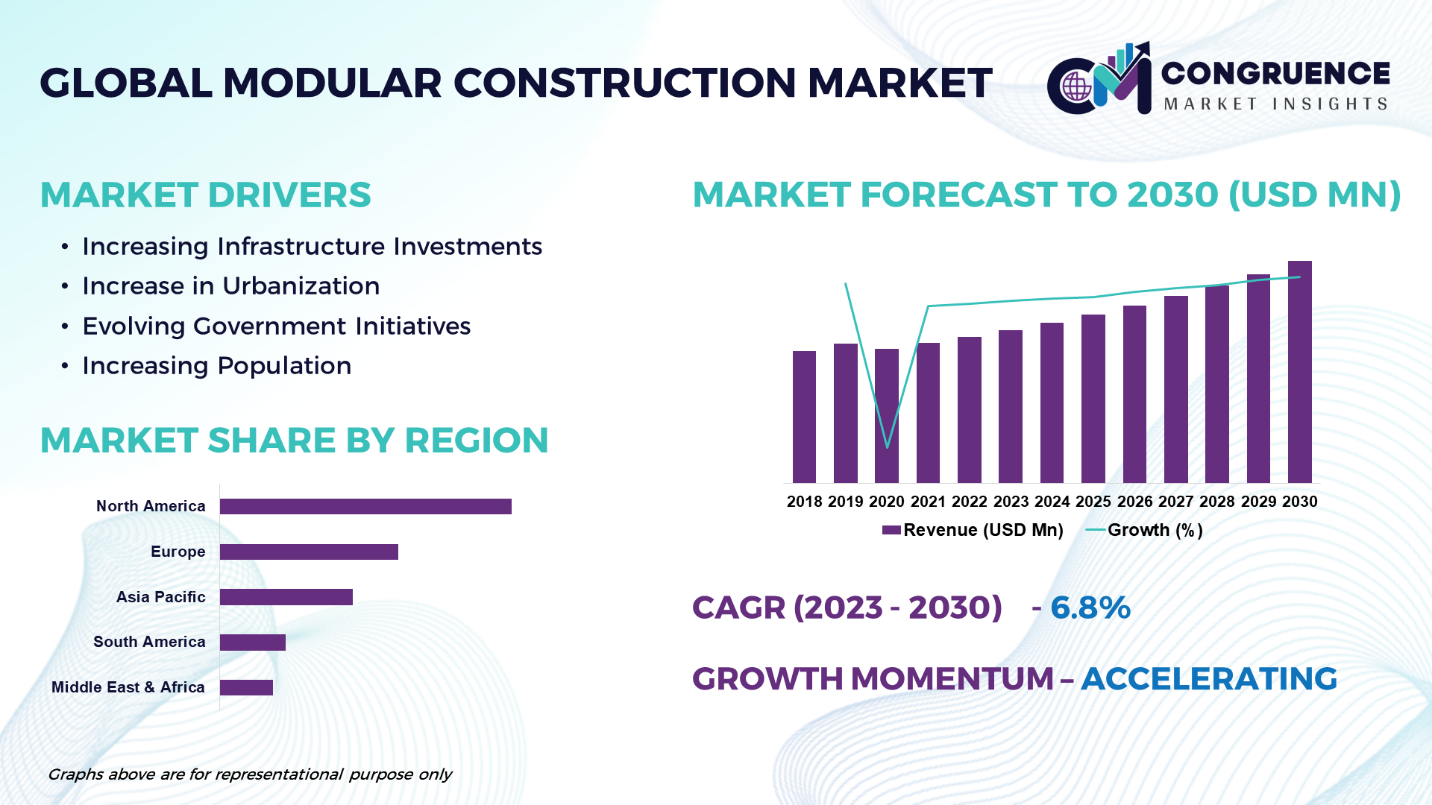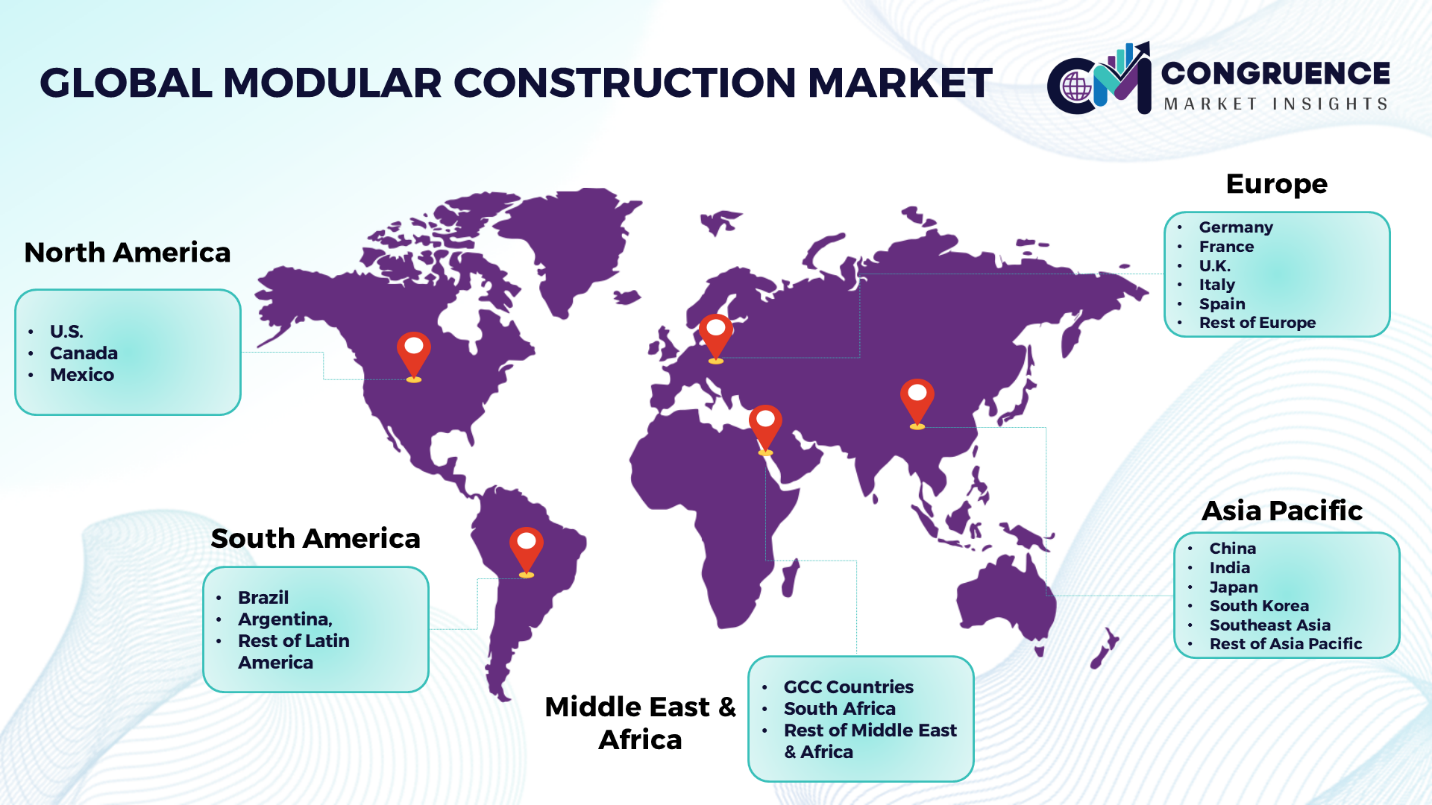Reports
The Global Modular Construction Market is expected to expand at a CAGR of 6.8% between 2023 and 2030. Modular construction is a process in which a building is constructed off-site, under controlled plant conditions using the same design and materials to the same codes and standards as conventionally built facilities but in about half the time. These buildings are produced in modules that when put together on site, reflect the identical design intent and specifications of the most sophisticated site-built facility without compromise. Modular construction is utilized for permanent or temporary facilities such as classrooms, military housing, construction camps, and industrial facilities. Modular buildings are used in remote areas where conventional construction is not possible. Furthermore, the modular construction buildings occur simultaneously with site work, allowing projects to be completed in half of the time of traditional construction. Moreover, modular construction finds its major application in healthcare facilities, churches, fast food restaurants, and commercial offices. A modular construction material generally includes wood, steel, concrete, among others. The market is influenced by factors such as increasing infrastructure investments, increase in urbanization, evolving government initiatives, and increasing population. The modular construction market serves residential, industrial, institutional, and commercial establishments such as hotels and hospitality businesses.

Modular Construction Market Major Driving Forces
Increasing Infrastructure Investments: The increasing infrastructure investments in emerging economies owing to the rise in industrialization is driving the market growth. Rising commercial space investments are significantly contributed to the prefabricated construction market growth.
Increase in Urbanization: The growth of the global modular construction market is driven by growing urbanization in developing countries. The rapid rise in urban populations creates a high demand for affordable and quickly produced housing solutions. Moreover, upsurge in population is anticipated to have a significant impact on the growth of the market.
Evolving Government Initiatives: The modular construction market is driven by the advancing government initiatives to reduce construction waste and promote green buildings. Moreover, many governments give companies incentives that help standardize modern construction methods.
Increasing Population: The need for residential and commercial structures has been increased due to growth of the population. Modular construction techniques provide a quick and effective way to address the housing needs of expanding populations. In addition, modular buildings provide more designs and modification flexibility, making it a better choice for construction projects.
Modular Construction Market Key Opportunities
Technological Advancements: The advancements in the construction techniques and innovations are expected to create lucrative opportunities for market growth. Innovations in design software, 3D printing, and building materials are creating opportunities for enhancing the efficiency and capabilities of modular construction. Advanced and innovative manufacturing techniques are leading to more precise and durable modules.
Sustainability: The increasing demand for sustainable construction practices is expected to create significant opportunities for market expansion. Modular construction offers significant benefits in terms of reduced waste, lower energy consumption, and improved environmental performance compared to traditional construction techniques. Owing to increasing environmental concerns, governments are increasingly promoting sustainable construction practices.
Increasing Awareness: The shift in awareness towards the use of modular buildings is expected to open up growth opportunities in the modular construction market globally. Off-site building units such as walls, floors, rooms, and frames are associated with the industry. Customers surging preference for modular buildings has encouraged modular construction market to broaden their manufacturing and assembly design capabilities.
Modular Construction Market Key Trends
· The growing infrastructural expansion and building activities in developing countries is a market key trend contributing to the market growth
· Rapid growth and industrialization leading to increase the number of new projects significantly in the marketable and industrial building sectors
· Increasing technological progresses in the building industry coupled with the advantages provided by modular construction such as reduced cost, greater flexibility, and less material waste
· Technological integration in construction process such as building information modeling(BIM), 3D printing that allows for precise planning, revolutionize module production, and optimization of modular projects
· With the growing focus on sustainability, there has been increase in adoption of recycled materials, and low-carbon manufacturing processes in modules
· Growing use of digital technologies in the global modular construction market is one of the key market trend
· Smart manufacturing technology deployment is a notable trend in the market to enhance the product demand by improving operational performance

Market Competition Landscape
The global modular construction market is characterized by high degree of competition among a large number of manufacturers. The major players operating in this market are focusing on mergers and acquisitions. Key players in the modular construction market engage in strategies aimed at gaining a competitive edge. These strategies include product innovation, design differentiation, and the incorporation of sustainable and eco-friendly manufacturing practices to meet evolving consumer preferences. Established brands leverage their reputation for quality and reliability to maintain market share, while newer entrants focus on disruptive innovations and unique selling propositions.
Key players in the global modular construction market implement various organic and inorganic strategies to strengthen and improve their market positioning. Prominent players in the market include:
· Sekisui House Ltd.
· Skanska AB
· Red Sea Housing
· Laing O'Rourke
· Clayton Homes Inc.
· Cavco Industries Inc.
· Bouygues Construction
· KLEUSBERG GmbH & Co. KG
· ATCO
· Modulaire Group
· Wernick Group
· Fluor Corporation
· Premier Modular Limited
· Lendlease Corporation
|
Report Attribute/Metric |
Details |
|
Base Year |
2022 |
|
Forecast Period |
2023 – 2030 |
|
Historical Data |
2018 to 2022 |
|
Forecast Unit |
Value (US$ Mn) |
|
Key Report Deliverable |
Revenue Forecast, Growth Trends, Market Dynamics, Segmental Overview, Regional and Country-wise Analysis, Competition Landscape |
|
Segments Covered |
· By Type (Permanent, and Relocatable) · By Material Type (Steel, Wood, Concrete, and Others) · By Module Type (Four-sided, Open-sided, Partially Open-sided, Mixed Modules & Floor Cassettes, and Others) · By End-use Industry (Healthcare, Education, Hospitality, Retail & Commercial, Offices, and Others) · By Application (Residential, Commercial, Industrial, Institutional, and Others) |
|
Geographies Covered |
North America: U.S., Canada and Mexico Europe: Germany, France, U.K., Italy, Spain, and Rest of Europe Asia Pacific: China, India, Japan, South Korea, Southeast Asia, and Rest of Asia Pacific South America: Brazil, Argentina, and Rest of Latin America Middle East & Africa: GCC Countries, South Africa, and Rest of Middle East & Africa |
|
Key Players Analyzed |
Sekisui House Ltd., Skanska AB,Red Sea Housing,Laing O'Rourke,Clayton Homes Inc.,Cavco Industries Inc.,Bouygues Construction,KLEUSBERG GmbH & Co. KG,ATCO,Modulaire Group,Wernick Group,Fluor Corporation,Premier Modular Limited, and Lendlease Corporation |
|
Customization & Pricing |
Available on Request (10% Customization is Free) |
